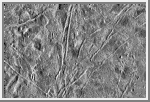
Flows on Europa
| Ice Volcanoes Reshape Europa's Chaotic Surface |
|---|
Ice-spewing volcanoes and the grinding and tearing of tectonic plates have reshaped the chaotic surface of Jupiter's frozen moon Europa, images from NASA's Galileo spacecraft reveal.

The images, captured when Galileo flew within just 430 miles (692 kilometers) of Europa on Dec. 19, were released at a news briefing today at NASA Headquarters, Washington, DC.
Although the images do not show currently active ice volcanoes or geysers, they do reveal flows of material on the surface that probably originated from them, said Galileo imaging team member Dr. Ronald Greeley of Arizona State University, Tempe.
"This is the first time we've seen actual ice flows on any of the moons of Jupiter," said Greeley. "These flows, as well as dark scarring on some of Europa's cracks and ridges, appear to be remnants of ice volcanoes or geysers."
The new images appear to enhance Europa's prospects as one of the places in the Solar System that could have hosted the development of life, said Greeley.
"There are three main criteria to consider when you are looking for the possibility of life outside the Earth -- the presence of water, organic compounds and adequate heat," said Greeley. "Europa obviously has substantial water ice, and organic compounds are known to be prevalent in the Solar System. The big question mark has been how much heat is generated in the interior.
"These new images demonstrate that there was enough heat to drive the flows on the surface. Europa thus has a high potential to meet the criteria for exobiology," Greeley added.
"This doesn't prove that there is an ocean down there under the surface of Europa, but it does demonstrate that it is a scientifically exciting place," said Galileo imaging team member Dr. Robert Sullivan, also of Arizona State University.

The images also reveal a remarkable diversity in the geological age of various regions of Europa's surface. Some areas appear relatively young, with smooth, crater-free terrain, while others contain large craters and numerous pits, suggesting that they are much older.

The icy crust bears the signs of having been disrupted by the motion of tectonic plates. "There appear to be signs of different styles of tectonism," said Greeley. "In many areas we see that the crust was pulled apart in a spreading similar to the processes on the sea floor on Earth. This is different from the tectonic processes at work on, say, Jupiter's moon Ganymede. This suggests that Europa's interior may be different from Ganymede's."
Galileo scientists will have a better chance to understand Europa's interior when the spacecraft gathers gravity data on another flyby next November. The gravity field is measured by tracking how the frequency of Galileo's radio signal changes as it flies past the moon. This was not possible during the recent flyby because radio conditions were degraded as Jupiter passed behind the Sun from Earth's point of view.

Europa is crisscrossed by an amazingly complex network of ridges, according to Sullivan. "Ridges are visible at all resolutions," he explained. "Closely paired ridges are most common. With higher resolution, ridges seen previously as singular features are revealed to be double."
Some of the ridges may have formed by tension in the icy crust: as two plates pull apart slightly, warmer material from below might push up and freeze to form a ridge. Other ridges may have been formed by compression: as two plates push together, the material where they meet might crumple to form the ridge.
In addition to ice flows and tectonics, Greeley and Sullivan noted that some areas on Europa seem to have been modified by unknown processes that scientists are still debating. Greeley said that some areas, for example, seem to have been modified by "sublimation erosion" -- the evaporation of water and other volatiles such as ammonia and methane into the vacuum of space. "Something is destroying the topography," said Greeley, "and this sublimation erosion is a good candidate for what is at work."
During last month's encounter, Galileo flew more than 200 times closer to Europa than the Voyager 2 spacecraft did in 1979. After a swing past Jupiter next week in what mission engineers call a "phasing orbit," Galileo's next targeted flyby will take it again past Europa as it passes within 364 miles (587 kilometers) on Feb. 20.
The Jet Propulsion Laboratory, Pasadena, CA, manages the Galileo mission for NASA's Office of Space Science, Washington, DC.
Douglas Isbell Headquarters, Washington, DC January 17, 1997 (Phone: 202/358-1753) Sender: owner-press-release Precedence: bulk Franklin O'Donnell Jet Propulsion Laboratory, Pasadena, CA (Phone: 818/354-5011) RELEASE: 97-12